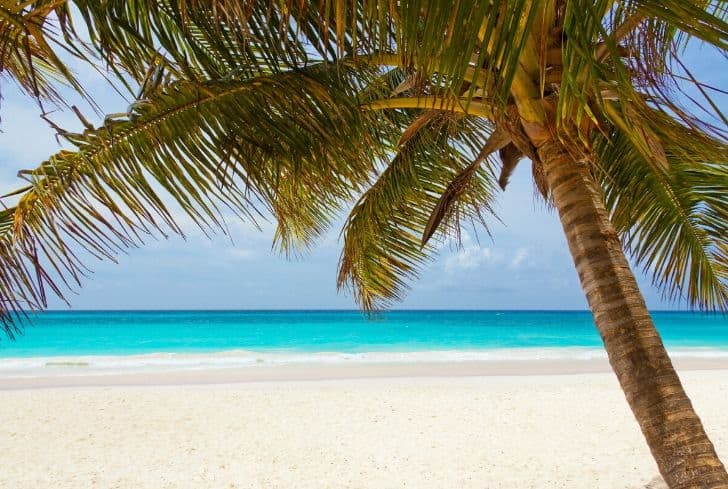Primarily found in temperate regions, Palm Trees are a group of lofty, fruit-bearing trees. They belong to the Botanical family of shrubs and lianas and are the only member of the Arecaceae group of trees. While there are almost 2,600 different species of Palm Trees, the most common variants include the Date and Coconut Palm.
That said, what are the other different types of palm trees and how much do they cost? How long does it take for a Palm tree to grow? What is the growth rate of these trees? Let’s clear the air!
As previously mentioned, Palm Trees are large, leafy, fruit-bearing trees that are primarily found in arid and tropical regions. The defining quality of these trees lies in their beautiful leaves and delicious fruits.
Most palm trees have a significantly longer life and depending on the type, they can even live up to a hundred years. Over the years, gardening enthusiasts have created hybrid variants of palm trees that can be kept in smaller areas like your apartment or office space. Depending on the variety, Palm Trees are fairly easy to grow and extremely cost-effective.
How Much Different Types of Palm Trees Cost?
Palm Trees may be classified into multiple types. In this section, we will take a closer look at them.
Chinese Palms
These are a type of Indoor Palm Tree that stands out due to their beautiful leathery leaves. While they are relatively slow-growing when compared to other variants of Palm, upon maturing, the Chinese Palm may achieve a height of 15 to 17 feet.
Chinese Palm trees thrive well in areas receiving ample sunlight and their younger variants may even survive the shade. For best results, use a mild fertilizer on this Palm tree during the End Summer or Spring months.
Cost: Chinese Palms can cost you anywhere between $60 to $66
Kentia Palm
This is yet another beautiful Palm Tree with large, wide leaves growing up to one foot. As with the Chinese Palm, they are extremely slow-growing, requiring a set of frons only once a year.
While the mature Kentia Palm may be extremely tall, it will take the tree several years to achieve the said length. Due to the slow-growing nature of the plant, you do not need to re-pot them either.
Kentia Palms are native to the Australian region, and there, they are also known as the Paradise Tree/ Paradise Palm. Like the Chinese Palm, they have feathery leaves with tiny fonds. Kentia Palms can comfortably grow in both bright and indirect sunlight. In some rare instances, they may also withstand low light.
Upon getting the plant, you need to water it at least once a day. While doing this, make sure the upper layer of the soil has completely dried out and keep misting it once in a while to boost the humidity level.
Cost: Kentia Palms can cost you anywhere between $100 to $400
Parlor Palm
As you’d probably guess from the name, Parlor Palm is one of the best indoor Palm Trees. They exhibit an average growth under indoor light and do not require much pruning either.
Parlor Palms tend to flourish in areas with high humidity and in some instances, they may attract pests like spider mites. To avoid this, always make sure the branches are occasionally tidied and the plant is never left dry.
Cost: Parlor Palms can cost you anywhere between $80 to $15
Pygmy Palm: Wide found in the Southeast Asian regions, these plants can grow a whopping 10 feet when kept outdoors and around 3 to 6 feet when kept indoors.
Featuring a large trunk and elongated leaflets, this plant looks spectacular, to say the least. As with many other palm treas featured on this list, the Pygmy Palm is a kind of feathered palm that exhibits a moderate to slow growth.
For best results, grow this plant in an area that has a perfect mix of brightness and shade. Besides, also ensure it receives plenty of indirect light. Avoid overwatering or repotting this plant from time to time. These plants have sensitive roots and should be kept rootbound most of the time.
Cost: A quality Pygmy Palm will cost you around $50 to $55
Fishtail Palm
This is a type of feathered palm. However, it wouldn’t appear feathered in the first instance. Unlike regular palm trees, the foliage of fishtail palms resembles fishtails, thus the name.
This tree is abundantly found in parts of India, Asia, and Pacific regions. As of now, however, you will find it in parts of Florida and the Caribbean as well. If you’re planning to grow it at home, consider doing it in a container, especially when the plant is at a younger and relatively manageable size.
Unlike other palm trees, it is not comfortable in colder parts and can only withstand temperatures up to 32 degrees Fahrenheit. So if you are living outside the zones 10 and 11 (USDA), you might have to get this indoors during the winter months in a bid to protect it from frost and cold wind.
On average, fishtail palms can assume a size of 15 to 20 feet and in most cases, they are large enough to be transported. That is why you should only consider growing this plant if you live in a temperate or tropical region.
Cost: While the cost of Fishtail Palms tends to vary, it is likely to cost you from $80 to $100 on average.
Sentry Palm
The Sentry Palm almost resembles the Kentia Palm with a few minor differences. Unlike the Kentia Palm that boasts a bunch of wide leaves, the Kentia Palm has fairly narrow and elongated leaves.
Its fronds tend to be attached and the leaves are slightly curly. This is also the reason why Sentry Palms are often interchangeably known as the Curly Palm.
In terms of growth, Sentry Palm witnesses moderate to slow growth. In most cases, it can reach lofty heights reaching up to 10 feet or more. This is unbelievably tall for an indoor plant.
The stature of this plant makes it a point of interest in lobbies, shopping malls, and entrance gates of offices. If you are planning to grow it indoors, make sure it receives ample indirect light. Besides, you should also mist it from time to time.
Cost: Sentry Palms will cost you between $159 to $360 depending on the quality.
Needle Palm
Alternatively known as the Needle Palmetto, this Palm is one of the best Palm Trees to grow in cold regions. It is hardy and can successfully sustain in almost every soil type. In most cases, the Needle Palm is known to survive temperatures under minus five degrees Fahrenheit. Upon maturing, it can also grow in completely shaded areas. Do note, however, that Needle Palms require a massive space for growth.
A unique feature of these palms lies in their needle-shaped leaves that are both sharp and edged. Since these leaves may be clumped right from the ground, this may not be a perfect indoor plant. You can, however, still consider growing it in your indoor garden.
The tree has a moderate growth rate and survives best when watered frequently. Do note that it doesn’t withstand salt spray. So, if you live near the ocean, consider avoiding this possibility.
Cost: Needle Palms will cost you between $24 to $99 depending on the quality
Diamond Palm
The Diamond Palm is best known for its massive leaves and incredibly lofty structure. At outset, it’ll appear as if the plant is directly rising from the ground. However, in reality, it does come with a trunk- since the trunk is subterranean, it mostly sits under the ground level.
The leaves of the diamond palm are structured like fans, resembling the paper fans made by kids. Their pattern is also similar to that of a pleated skirt.
Diamond Palms are widely found in the rainforests of Thailand, Malaysia, and other southeast Asian countries. They usually grow in shade right under the bigger trees. If you’re planning to plant these trees in your garden, do ensure that it gets plenty of shade and ample humidity. In addition, you should also water it at least once a day.
Cost: Diamond Palms may cost you $100 or more
Bottle Palm
Bottle Palms are best known for their unique appearance, primarily owing to the trunk. Unlike common palms, the trunk of Bottle Palms bulge from the end making it appear like a bottle. This tree can perfectly grow out of a container while still maintaining a compact size. Upon maturing, they can reach a height of 12 feet (at most).
The Bottle Palm Tree also boasts excellent foliage. The foliage arches on the fronds and most trees usually feature five to six fronds. The Bottle Palm tree is ideal for growing outdoors. It thrives best in USDA zones 8 to 11.
Cost: Bottle Palm trees may cost you between $40 to $60 on average.
How Much Does it Cost To Remove Palm Trees?
On an average, you need to shell out between $200 to $500 to remove a palm tree of up to 30 feet (in height). If, however, the tree is extremely tall (between 50 to 80 feet) you might need to spend $1000 to $1500 to get it completely felled.
Note: The costs mentioned here are subjective and can vary depending on your location and service provider.
How Long Does it Take For a Palm Tree to Grow?
The time taken for Palm Trees to grow entirely depends on the variety and the type of the tree. Usually, it takes around four to six years for an average palm tree to reach a mature stage. However, depending on the variety it may take even longer.
Some palm trees, like the Corypha palm, takes around four to five decades to bear fruits, while others like the coconut palm can bear fruits in just eight to ten years. Either way, the time taken for the palm tree to grow will depend on the environment, soil type, and other underlying conditions.
How Much do Palm Trees Grow a Year?
While some palm trees may take two to three years until they reach one foot in size, others can grow up to 4 to 6 feet every year. At the end of the day, the growth of the palm tree will depend on the type of tree and its growing conditions.
Well, these were some of the most popular variants of Palm trees there is. Since most of them are quite affordable, make your pick and spruce up your home or office space with these beautiful trees.
References:







